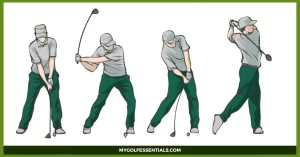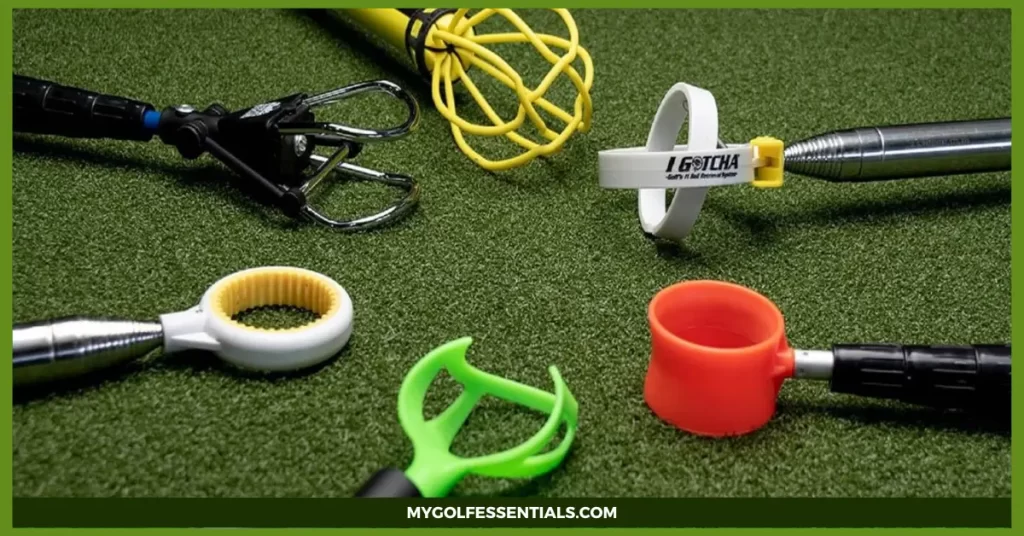
Are you looking to improve your golf game? Have you been struggling with consistently hitting the ball straight and long? If so, it’s time to learn how to swing a golf club!
Whether your goal is recreation or competition, perfecting one’s swing can make a huge difference in one’s enjoyment of the sport.
This blog post aims to provide readers with a detailed breakdown of every element involved in crafting an effective golf swing basics – allowing readers from all playing levels to realize their potential out on the fairway.
Going into detail about proper grip technique, mechanics, and more, read on for comprehensive insight on how you can master swinging a golf club!
Overview of Different Types of Golf Clubs and Grips
When swinging a golf club, the type of club and grip you use can make a huge difference. There are four main types of golf clubs: woods, irons, wedges, and putters. Woods typically have long shafts and large heads that help generate greater distances from shots.
Irons are usually shorter and offer more control over the ball’s trajectory. Wedges are used mostly for short-distance shots, especially when approaching a green. Putters have shorter shafts and very flat faces that help to keep the ball in a straight target line.
Grips are also important because they determine how firmly you hold the club and the type of shot you can generate. The two main types of grip are overlapping and interlocking grips.
Overlapping grips overlap your pinky and index finger on either hand, whereas interlocking grips are when the pinky and index finger “lock” together. Choosing a grip that feels comfortable for you is important as it will help you swing more consistently and accurately.

Understand the basics of golf – grip, stance, and ball position
Swinging a golf club correctly is the key to successful and enjoyable golf. Before starting, you should understand the basics of grip, stance, and ball position.
The grip is how you hold the club in your hands. Golfers use three primary grips: overlapping, interlocking, and 10-finger (or baseball) grip. The overlapping grip is the most popular for many, as it provides the best feel and control of the club.
Your stance is how you position your body concerning the ball. Your feet should be shoulder-width apart, with your left foot slightly ahead of your right foot if you are a right-handed golfer. You should bend your knees slightly and lean forward from the waist, with your arms hanging naturally down from your shoulders.
Steps for Properly Holding a Golf Club
1. Place your left hand on the club’s grip with your palm facing the ground and wrap your fingers around it so your thumb points towards the top.
2. Position your right hand below your left so that both thumbs are placed on top of each other, and then wrap your fingers around the grip.
3. Make sure your left palm is parallel to the ground and facing slightly to the right, while your right palm should club face upwards.
4. Place your hands on the grip with equal pressure, ensuring that they are centered, and keep a light grip so that you can swing freely without tension.
5. Raise the club and hold it over your shoulders with an arm’s length distance between them.
6. Swing the club out to the side, keeping your arms close together, pivoting around your waist, and maintaining a steady tempo throughout the swing.
7. As you reach the top of your backswing, allow for a slight wrist cock, so that your wrists rotate slightly outward.
8. Transfer your weight to the left side and start the downswing by releasing the golf club head away.
9. Swing through the ball with a smooth and steady tempo, ensuring you use both arms equally throughout the entire swing.
10. After making contact with the ball, turn your body toward the target and follow through until your arms have reached full extension.
Learn the different types of swings and how to execute them correctly
To swing a golf club properly, you must first become familiar with the different types of swings. Each swing type is slightly different regarding stance, ball position, and body movement.
The most basic swing is the one-piece takeaway, which involves taking the club away from the ball on a single plane until it reaches the top of your backswing. For this type of swing, it is important to maintain a consistent tempo and use the same backswing for every shot.
For a slightly more advanced swing, you can try a two-piece takeaway. This involves loading your weight on your left side as you take the club away from the ball on the initial plane, then shifting your weight to generate power in the downswing.
The next is a one-piece downswing. This approach starts with a long backswing that avoids tension and uses only the arms to move the club away from the ball. It then shifts into a powerful downswing, with all your body weight, arms, and torso working together to generate power.
Practice your swing in a safe environment, such as a driving range or practice course
Once you have the basics of how to swing a golf club down, it is important to practice your technique to improve.
The best way to do this is by visiting a driving range or practice course so that you can make adjustments and get used to making full swings with different types of clubs. When practicing, use some tees and balls to get a feel for your swing’s natural arc and motion.
Focus on different parts of your swing, such as posture, grip, and backswing. Also, practice aiming at different targets to ensure your shots go where you want them to go. Once you have built up some confidence practicing at a driving range or practice course, you can apply your skills to the golf course.
Make sure that you are always taking safety precautions when playing, and if possible, get some advice from an experienced golfer about any issues you may be having with your swing. With enough time and patience, you will soon be able to master how to swing a golf club and start having fun on the golf course.
How to Swing a Golf Club – Step-By-Step Golf Swing
Swinging a golf club is one of the game’s most important aspects. When done correctly, it can help you hit longer and straighter shots, reduce your score and give you a better experience on the course. Here are some tips on how to swing a golf club properly:
1. Start by gripping the club. The two most common grips are the overlapping and interlocking grip but experiment and see which works best for you. You can also adjust your grip pressure to find a comfortable fit.
2. Once your grip is set, take a stance with your feet about shoulder-width apart and turn slightly toward the target. Ensure your knees are slightly bent and your weight is balanced on both feet.
3. Start the backswing by shifting your hips to the right while turning your shoulders and arms away from the ball. From here, keep turning until your left arm is straight and you feel balanced.
4. At this point, you should be ready to begin your downswing. Keep your left arm straight and rotate through the hitting area with your arms, shoulders, and hips in unison.
5. As you reach the bottom of the swing, focus on driving the clubhead downward toward the ball while keeping your weight balanced throughout.
How to Swing a Golf Club – Step-By-Step Golf Swing
Swinging a golf club can be intimidating for beginners, but with practice and following these steps, you’ll soon be on your way to mastering the perfect swing:
1. Start by standing in a relaxed and balanced position. The feet should be shoulder-width apart and slightly staggered – the left foot slightly ahead of the right – and you should be pointing at your target.
2. Equip yourself with a suitable grip: place your left hand on the club first, wrapping your fingers around the handle so that they overlap each other.
Place your right hand over the top of your left, matching thumbs for alignment. The “V” formed by the thumb and forefinger on each hand should point towards the right shoulder.
3. With your feet in place, turn your hips slightly to the left and draw back the club with extended arms. Your elbows should stay close together throughout this part of the motion as you coil your body around the spine.
4. Now to the downswing! Releasing all your tension, start by uncoiling the body back towards the ball. As you do so, let the arms swing freely and allow them to separate as they move downwards.
Tips for Improving Your Swing and Technique
There are a few important tips to remember to improve your swing technique. First, ensure you’re always focused on the ball before swinging. Keeping your eyes on the ball is key to hitting it properly and accurately.
Furthermore, when you set up for the shot, take a few moments to ensure you’re in an athletic stance, with your feet shoulder-width apart, knees slightly bent, and arms relaxed.
Also, be conscious of the weight shift in your swing; when you address the ball, your weight should be distributed more toward your front foot. As you swing back, shift your body weight onto the back foot.
Then, as you move your club forward for the downswing, shift your weight back to the front foot. This will help you get more power and accuracy behind each shot.
Keep your head still when coming through with the swing; don’t allow it to drop or tilt during the swing. Remember to finish with your hips and shoulders in the same position you started, allowing your arms and wrists to naturally follow through with the swing without interference.
Benefits of Practicing with a Professional Instructor
Learning to swing a golf club from a professional instructor is extremely beneficial for those looking to improve their game. Professional instructors have the experience and knowledge necessary to diagnose and correct swing irregularities that may be causing you difficulty in your game.
With their help, they can provide tailored advice on grip, stance, posture, and more and teach you how to properly use your body weight during the swing.
Additionally, they can help you improve your aim and accuracy while developing a consistent swing that will help you achieve better scores. Visiting a professional instructor is an invaluable part of mastering the game of golf.
Get tips from experienced golfers on technique and gear selection
If you seek expert advice on swinging a golf club, many experienced golfers can provide guidance and helpful tips. These knowledgeable individuals can help you determine the right grip, stance, and width. Additionally, they can assist with club selection, offering insight into various shaft flexes, head styles, and shaft lengths.
Furthermore, experienced golfers can advise on the best gear for your swing. They can help you find the perfect set of irons for your game, providing insight into blade length and offset design considerations. Additionally, they may recommend a particular driver or fairway wood that will work well with your swing.
Moreover, experienced golfers can give you tips on how to practice and fine-tune your technique. They may suggest drills specific to the type of shot you want to hit and provide guidance for building muscle memory to maintain consistency over time.
Additionally, they can offer insight into how various environmental factors, such as wind and terrain, can affect your club selection.
All in all, experienced golfers can be great resources for learning how to swing a golf club. With their knowledge and advice, you will be confident to take your game to the next level.
How to Choose the Right Golf Clubs for Your Skill Level
Once you’ve mastered the basics of swinging a beginner golf lessons club, the next step is choosing the right clubs for your skill level. There are many different types of clubs designed for different types of players and shots.
The most important thing to remember when choosing golf clubs is that they should be suited to your individual swing and skill level. Beginners should opt for clubs with more forgiving designs that can help minimize mistakes, while more experienced players may want to look for clubs designed to optimize performance.
A set of irons (3-9) is recommended for most beginner golfers as they offer the most versatility in different shots and lie conditions. Mid-handicappers may also want to add a few extra clubs, like wedges, for more control around the green.
Examples of Common Golf Club Mistakes to Avoid
One of the most common mistakes when learning how to swing a basic golf swing club is that many beginners try to use too much arm force while swinging. This can cause an inconsistent swing, resulting in shots lacking direction or distance.
It’s important to know how to keep your arms relaxed during the backswing and follow through to improve accuracy. Another common mistake is not taking enough practice swings before hitting the ball.
Many beginners rush into trying to hit their shots and do not take enough time between swings to get the feel of how much force they need to use or the most efficient way to swing a club. Practice swings allow you to adjust your technique while getting comfortable with the club before you hit the ball.
Finally, many beginners also fall into the trap of swinging too fast, which can cause a loss in power and accuracy. Building up momentum throughout your backswing and following through is important to maximize your swing speed and power.
Pay attention to your grip pressure – too much or too little can lead to bad shots
Gripping the golf swing errors correctly can mean the difference between a solid shot and one that slices off to the side. When first picking up your club, have a light grip with equal pressure on both hands.
It’s important not to squeeze too tightly because this will constrict your arms and shoulders in the swing, resulting in poor contact with the ball.
While you want to avoid gripping too tightly, securing your hold on the club is also important. Too little grip pressure can cause you to lose control of the club during your swing, leading to mis-hits.
Improving your golf swing requires dedication and practice. Start by focusing on your form and the basics of the swing.
Ensure you maintain proper posture, that your weight is evenly distributed, and that you maintain a steady rhythm as you move through the motion. It’s also important to loosen up before each game by stretching and warming up with a few practice swings.
Developing the right grip pressure is key to mastering how to swing a golf swing tips club. Experiment with different pressure levels until you find one that works for you.
FAQs
How do I swing a golf club?
Swinging a golf club is an essential part of playing the game, and there are several steps you need to take to ensure you’re doing it correctly.
Start by taking your stance behind the ball with your feet shoulder-width apart. Then, grip the club firmly while ensuring your arms are relaxed.
What Is The Proper Posture For Swinging A Golf Club?
To achieve an effective swing, you must maintain a good golf posture. Start by standing with your feet shoulder-width apart and bent slightly at the knees.
Keep your arms relaxed and close to your upper body, which will help develop a greater rhythm during the swing. Your back should stay straight as you follow through, and your weight should be evenly distributed on both feet.
What is the best way to practice my golf swing?
Before hitting balls on the range, practice your swing before a mirror. Please pay attention to the details of each move and how they all come together with a consistent rhythm for an efficient swing.
You can also practice your swing with an empty club to become comfortable and develop a feel for the movement. Finally, take your practice swings on the range before hitting actual balls. This will help you warm up and focus on your technique as you hit each golf shots.
How can I improve my golf swing?
Improving your golf swing requires dedication and practice. Start by focusing on your form and the basics of the swing.
Ensure you maintain proper posture, that your weight is evenly distributed, and that you maintain a steady rhythm as you move through the motion. It’s also important to loosen up before each game by stretching and warming up with a few practice swings.
Conclusion
I hope you have enjoyed learning about the basics of how to swing a golf club. Remember, practice makes perfect, so don’t be discouraged if it takes time to get the technique right. With dedication and determination, you’ll be hitting those golf ball straight down the fairway in no time!



